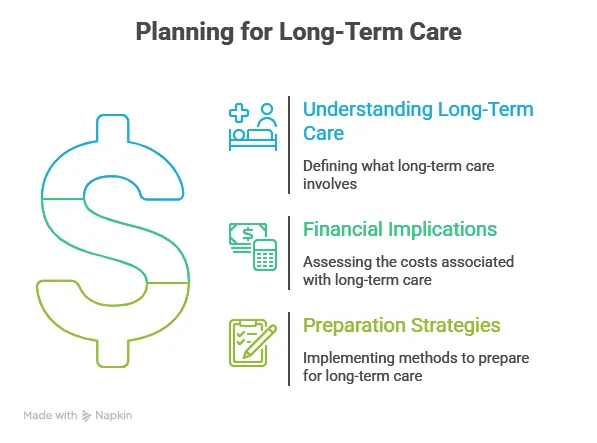
The Biggest Threat to Your "Financial House"? A Plain-English Guide to Long-Term Care
When we work together to build your retirement income plan, we're essentially building a strong "financial house" designed to support you for life. We focus on income streams, inflation, and market changes. But what about the risks that can threaten the house itself?
One of the biggest, and most often avoided, is the potential cost of long-term healthcare. It's a tough topic, but a crucial one. Statistics from the U.S. Department of Health and Human Services show that a majority of us, perhaps 60% to 70%, will likely need some form of long-term care assistance in our later years.
What Does "Long-Term Care" Actually Mean?
When I say "long-term care," I'm not just talking about a nursing home. It’s a broad range of services to help with daily activities you might start to find difficult.
This could be:
Help at home with meal prep, cleaning, or errands (homemaker services).
Hands-on help with bathing, dressing, or eating (a home health aide).
Care in a dedicated facility, like an assisted living community.
More intensive, 24/7 care in a nursing home.
The Elephant in the Room: The Staggering Cost
The reason this is such a critical part of planning is that the costs are substantial, and frankly, they are often underestimated. These numbers can be jarring, but it's important to see them. According to a 2024 Genworth Cost of Care Survey, the annual median costs are eye-opening:
Homemaker Services: $75,504
Home Health Aide: $77,792
Assisted Living Community: $70,800
Nursing Home (Semi-Private Room): $111,325
Nursing Home (Private Room): $127,750
These are per year. Seeing these figures makes it clear why a plan is essential, especially since traditional health insurance and Medicare won't cover these expenses.
The Great Misconception: "Won't Medicare Pay for It?"
This is the single biggest—and most dangerous—misunderstanding I see. The answer is, almost certainly, no.
Let's be very clear: Medicare is health insurance. It pays for doctors, hospital stays, and treatments for illness or injury. It does not pay for what it calls "custodial care," which is that daily help with bathing, dressing, and eating.
There is a very limited exception. Medicare Part A may help pay for a short stay (up to 100 days) in a skilled nursing facility, but only after you’ve had a qualifying inpatient hospital stay of at least three days. It is not a long-term solution.
What about Medicaid?
Medicaid is the largest public payer for long-term care. But to get it, you must meet very strict, low-income and asset limits. This means you essentially have to "spend down" almost all of your life's savings first. Furthermore, Medicaid has a "look-back period" (generally 5 years in most states) to see if you've gifted money away to try to qualify, which can result in penalties.
Building the "Moat": Your Planning Options
If Medicare won't pay, and Medicaid is the last resort after you've spent everything, how do you protect your financial house? This is where proactive planning comes in. We build a "moat" to defend what you've built. Here are the primary tools we can look at:
Long-Term Care Insurance (LTCI): This is the traditional option, a policy designed specifically to cover these services. The downside is that it can be expensive, and it can be difficult to qualify if you already have health issues.
Hybrid Life Insurance Policies: These are increasingly popular. They combine a life insurance death benefit with a long-term care benefit. If you never need LTC, your heirs get the life insurance. If you do need care, you can access the benefit. This flexibility is very appealing.
Health Savings Accounts (HSA): If you have an HSA from your working years, it's a fantastic, triple-tax-advantaged tool. You can use that money tax-free for qualified medical expenses, which includes long-term care services.
Personal Savings & Investments: This is the self-funding option. It means relying on your own savings, pensions, or investment accounts. This requires earmarking specific assets and integrating it into your overall retirement income plan.
Home Equity: For some, tapping into home equity or using a reverse mortgage can be a source of funds.
Let's Have the Conversation
I know this isn't a fun topic. It's much easier to talk about travel or grandkids. But proactive planning for this "what if" is one of the greatest gifts you can give to yourself and your family. A well-thought-out strategy can protect your assets, ensure you get the quality care you deserve, and prevent financial stress on your loved ones.
This is not something you have to figure out alone. My job is to help you look at these risks and build a plan that fits your specific goals. If you'd like to review how this fits into your overall financial plan, please give my office a call or send an email. We're here to help.
